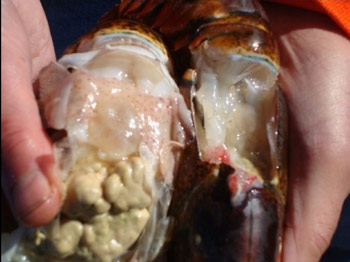High-speed Hauling Damages
Some Lobsters
by Laurie Schreiber

Lobster carapace removed from healthy lobster left and right, lobster with jelly heart caused by high speed passage to the surface. Lobster Institute photo.
PORTLAND—A new study, out of The Lobster Institute at the University of Maine in Orono, shows that high-speed hauling can kill lobsters whose rostrums—or mouths—are positioned upward during the hauling process.
Speaking at the 11th International Conference on Lobster Biology and Management—hosted in Portland from June 4-9 by the University of Maine and Boston University—the institute’s executive director, Bob Bayer, said that mortality was associated with clotted hemolymph and an enlarged “jelly” heart.
The condition was associated with the presence of a bacterium—Photobacterium indicum. The bacterium is usually found in the lobster gut. But an inspection of lobsters that died during the first 10 days after harvest showed the bacterium had entered their circulatory systems.
Bayer credited Hancock fisherman Herbert Hodgkins for the idea to study the topic. During preliminary work, the study team found that lobsters hauled with high-speed haulers looked fine when they reached the surface. But as much as 10-15 percent of the haul died while in holding for five to 10 days. Opening up the carapace, the team found a deteriorated heart.
“It’s very easy to see,” said Bayer. “What we have is a bacterial infection within the circulatory system. It’s almost always the same bacteria.”
To try to identify how the problem originated, the team set up experiments at a holding facility.
“We fed the lobsters, as soon as we got them, with an antibiotic to kill bacteria,” he said. “Virtually all the lobsters survived. So we had at least our first clue of what was happening.”
Thinking the root of the problem might be in the decompression process where the lobsters were raised from the seafloor, the team put lobsters in a hyperbaric chamber, released the pressure quickly, then put the lobster back into the sea in floating crates.
“They didn’t die. So it wasn’t just decompression,” he said.
The next step was to figure out why some lobsters died and other didn’t. The team realized that lobsters caught in the traps were hauled in various orientations—some with their mouths upward.
“What we think is happening is, those that have their mouths facing up are the ones that have massive amounts of water rushing into the mouth at high speed,” he said.
That would disrupt the digestive gland, forcing bacteria from the digestive gland into the circulatory system, he said.
To test this, lobsters were given high-pressure seawater, using a feeding needle attached to a syringe. The treatment resulted in mortality and a “jelly” heart.
“The solution is, Don’t be in such a hurry,” Bayer said. “But time is money, and if you want to ask fishermen to slow the speed of their haulers, which means reduced catches, you’re going to have to pay for it.”
